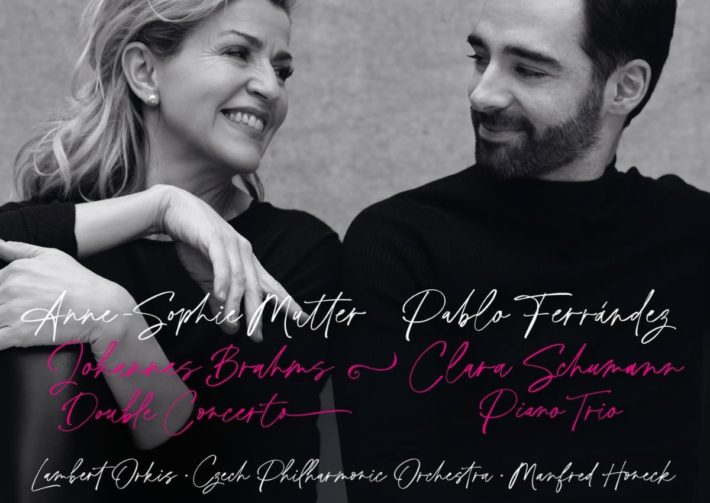Anne-Sophie Mutter’s new album features a revisitation of Brahms’ Double Concerto in A minor, this time with cellist Pablo Ferrández and the Czech Philharmonic led by Manfred Honeck. Listeners will recall that Mutter recorded the same work back in the ‘80s with Antonio Meneses and Karajan at the helm of the Berlin Philharmonic. The “Double Concerto” is followed by Clara Schumann’s G minor piano trio with Mutter’s long chamber collaborator, Lambert Orkis.
Intensity is the name of the game in Brahms, and not just in the most lively moments. The opening cello cadenza calls for moments of musical struggle, even conflict. Ferrández brings out these qualities very nicely indeed, but creates balances in the more tender parts of his solo, which (thanks to nuanced vibratos) have at times an achingly whispery quality. Mutter has her own moments to shine as well–listen to the short solo at 1’51” that swiftly transforms shades of piano into a bold forte. The same passage on her older recording is lovely, but I prefer the more raw and poignant edge she gives to the softer moments in the newer interpretation.
The third movement is the real highlight of the concerto. Once again, it opens with some fine playing from Ferrández, whose bow control lends to his solo two distinct perspectives: the first, a blend of resonance and buoyancy and the second, a supple and satisfying sostenuto in the legato passages. I do prefer his tempo to the noticeably slower one from Meneses, as it brings out the theme’s dance-like feel. The timbre of Ferrández’s cello itself is also a bit smoother. Mutter enters a few moments later with the same material; while the synchronicity of phrasing and articulation is evidently well thought-out, it’s nice to hear her unique personality come through. The rather jovial buoyancy of the cello translates into a lighter, elegant presence in the violin. Both performers not only show excellent attention to the articulation and intricacies of the composer’s textures throughout, but also to the sometimes abrupt change in character (i.e. 0’41”-0’53”).
Honeck wastes no time in the orchestral interlude (0’53” onward) to capitalize on the momentum Mutter gave us in the aforementioned 8 seconds: an almost urgent ferocity abounds with appropriately deliberate pushes from the strings (Karajan takes a more austere approach). The energy is satisfyingly present throughout–not only does it help tie the entire movement together, but it also feeds into the enthusiasm with which the soloists deliver their own performances. I did feel that Ferrández could have given us a bit more a true arrival (in terms of color) at the A major section (6’41”), something that Meneses does better with help from Karajan’s more successful phrase contouring moments before the cello’s entrance.
Related Posts
- Review: Tchaikovsky – Symphony No. 4, Leshnoff – Double concerto – Honeck
- Review: Brahms and Berg – Violin Concertos – Christian Tetzlaff
- Review: “Romance” – Isata Kanneh-Mason Plays Clara Schumann
The other half of the album comprises Clara Schumann’s G minor trio with help from pianist Lambert Orkis. For me, this performance was less successful on the whole. The Allegro Moderato has the elements of drama and pathos quintessential of a Romantic work; while the writing does lend a touch of elegant restraint, the performance could use more vibrant contrast: assertive moments weren’t forthcoming or emphatic enough, while the lyrical ones need even more coy charm. Part of it has to do with the piano part that on occasion felt matter-of-fact. The slow third movement (Andante) fares considerably better, with Mutter especially creating some beautiful lines. Her attention to the gradients of vibrato (0’27” onwards) gives the violin’s voice a human-like quiver.
While the balance of the sound engineering is good in the sense that it lets the two soloists come through clearly in the Brahms, I was a little bothered by the sheer amount of reverb that watered down the oomph of the ensemble–a real shame given the infectious energy of the performance. A few hits and misses don’t detract from the overall enjoyable listen, especially for the Brahms.

Brahms – Double Concerto & Clara Schumann – Piano Trio
Anne-Sophie Mutter – Violin
Pablo Ferrández – Cello
Czech Philharmonic
Manfred Honeck – Conductor
Sony, CD 19658741102
Recommended Comparisons
Read more classical music reviews or visit The Classic Review Amazon store
Follow Us and Comment:
[wd_hustle id=”HustlePostEmbed” type=”embedded”]











